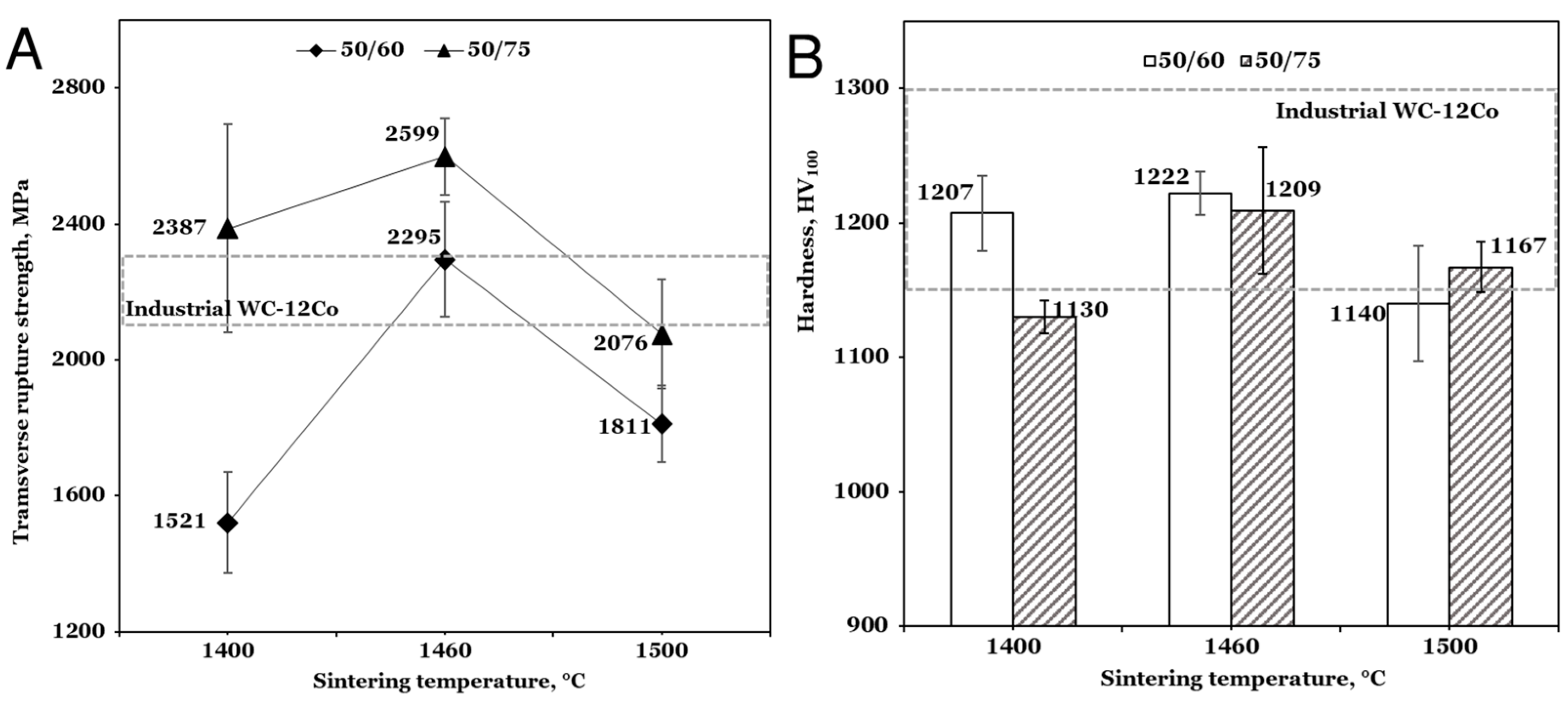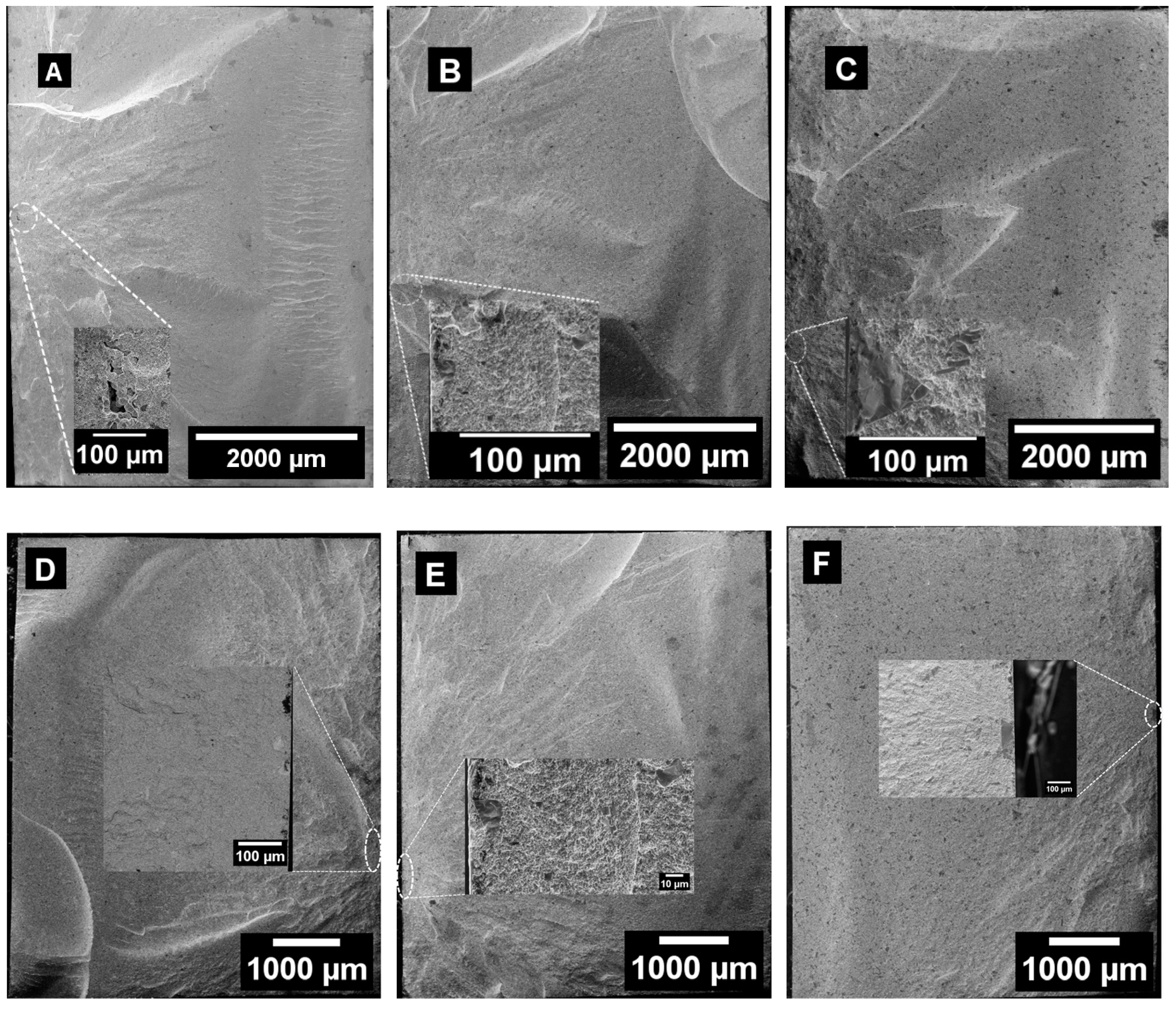Effects of Sinter-HIP Temperature on Microstructure and Properties of WC–12Co Produced Using Binder Jetting
Abstract
1. Introduction
2. Materials and Methods
3. Results
3.1. Powder Characterization
3.2. Microstructural Characterization
3.3. Mechanical Characterization
3.4. Defects
4. Conclusions
Author Contributions
Funding
Data Availability Statement
Acknowledgments
Conflicts of Interest
References
- Ettmayer, P.; Kolaska, H.; Ortner, H.M. History of Hardmetals. In Comprehensive Hard Materials; Sarin, V., Mari, D., Llanes, L., Eds.; Elsevier: Amsterdam, The Netherlands, 2014; pp. 3–27. [Google Scholar]
- Marshall, J.M.; Kusoffsky, A. Binder phase structure in fine and coarse WC–Co hard metals with Cr and V carbide additions. Int. J. Refract. Met. Hard Mater. 2013, 40, 27–35. [Google Scholar] [CrossRef]
- García, J.; Ciprés, V.C.; Blomqvist, A.; Kaplan, B. Cemented carbide microstructures: A review. Int. J. Refract. Met. Hard Mater. 2019, 80, 40–68. [Google Scholar] [CrossRef]
- Gee, M.; Gant, A.; Roebuck, B. Wear mechanisms in abrasion and erosion of WC/Co and related hardmetals. Wear 2007, 263, 137–148. [Google Scholar] [CrossRef]
- Padmakumar, M. Additive Manufacturing of Tungsten Carbide Hardmetal Parts by Selective Laser Melting (SLM), Selective Laser Sintering (SLS) and Binder Jet 3D Printing (BJ3DP) Techniques. Lasers Manuf. Mater. Process. 2020, 7, 338–371. [Google Scholar] [CrossRef]
- Uhlmann, E.; Bergmann, A.; Gridin, W. Investigation on Additive Manufacturing of Tungsten Carbide-cobalt by Selective Laser Melting. Procedia CIRP 2015, 35, 8–15. [Google Scholar] [CrossRef]
- Grigoriev, S.; Tarasova, T.; Gusarov, A.; Khmyrov, R.; Egorov, S. Possibilities of Manufacturing Products from Cermet Compositions Using Nanoscale Powders by Additive Manufacturing Methods. Materials 2019, 12, 3425. [Google Scholar] [CrossRef] [PubMed]
- Chen, J.; Huang, M.; Fang, Z.Z.; Koopman, M.; Liu, W.; Deng, X.; Zhao, Z.; Chen, S.; Wu, S.; Liu, J.; et al. Microstructure analysis of high density WC-Co composite prepared by one step selective laser melting. Int. J. Refract. Met. Hard Mater. 2019, 84, 4980. [Google Scholar] [CrossRef]
- Ku, N.; Pittari, J.J.; Kilczewski, S.; Kudzal, A. Additive Manufacturing of Cemented Tungsten Carbide with a Cobalt-Free Alloy Binder by Selective Laser Melting for High-Hardness Applications. JOM 2019, 71, 1535–1542. [Google Scholar] [CrossRef]
- Xiong, Y.; Smugeresky, J.E.; Ajdelsztajn, L.; Schoenung, J.M. Fabrication of WC–Co cermets by laser engineered net shaping. Mater. Sci. Eng. A 2008, 493, 261–266. [Google Scholar] [CrossRef]
- Davoren, B.; Sacks, N.; Theron, M. Laser engineered net shaping of WC-9.2wt%Ni alloys: A feasibility study. Int. J. Refract. Met. Hard Mater. 2019, 86, 105136. [Google Scholar] [CrossRef]
- Lengauer, W.; Duretek, I.; Fürst, M.; Schwarz, V.; Gonzalez-Gutierrez, J.; Schuschnigg, S.; Kukla, C.; Kitzmantel, M.; Neubauer, E.; Lieberwirth, C.; et al. Fabrication and properties of extrusion-based 3D-printed hardmetal and cermet components. Int. J. Refract. Met. Hard Mater. 2019, 82, 141–149. [Google Scholar] [CrossRef]
- Kitzmantel, M.; Lengauer, W.; Duretek, I.; Schwarz, V.; Kukla, C.; Lieberwirth, C.; Morrison, V.; Wilfinger, T.; Neubauer, E. Potential of Extrusion Based 3D-printed Hardmetal and Cermet Parts. In Proceedings of the World PM 2018, Bilbao, Spain, 14–18 October 2018; pp. 938–945. [Google Scholar]
- Jucan, O.-D.; Gădălean, R.-V.; Chicinaş, H.-F.; Bâlc, N.; Popa, C.-O. The Assessment of the Transversal Rupture Strength (TRS) and Hardness of WC-Co Specimens Made via Additive Manufacturing and Sinter-HIP. Metals 2023, 13, 1051. [Google Scholar] [CrossRef]
- Cramer, C.L.; Aguirre, T.G.; Wieber, N.R.; Lowden, R.A.; Trofimov, A.A.; Wang, H.; Yan, J.; Paranthaman, M.P.; Elliott, A.M. Binder jet printed WC infiltrated with pre-made melt of WC and Co. Int. J. Refract. Met. Hard Mater. 2020, 87, 5137. [Google Scholar] [CrossRef]
- Mudanyi, R.K.; Cramer, C.L.; Elliott, A.M.; Unocic, K.A.; Guo, Q.; Kumar, D. W-ZrC composites prepared by reactive melt infiltration of Zr2Cu alloy into binder jet 3D printed WC preforms. Int. J. Refract. Met. Hard Mater. 2020, 94, 105411. [Google Scholar] [CrossRef]
- Arnold, J.M.; Cramer, C.L.; Elliott, A.M.; Nandwana, P.; Babu, S.S. Microstructure evolution during near-net-shape fabrication of NixAly-TiC cermets through binder jet additive manufacturing and pressureless melt infiltration. Int. J. Refract. Met. Hard Mater. 2019, 84, 104985. [Google Scholar] [CrossRef]
- Cabezas, L.; Berger, C.; Jiménez-Piqué, E.; Pötschke, J.; Llanes, L. Testing length-scale considerations in mechanical characterization of WC-Co hardmetal produced via binder jetting 3D printing. Int. J. Refract. Met. Hard Mater. 2023, 111, 6099. [Google Scholar] [CrossRef]
- Enneti, R.K.; Prough, K.C. Effect of binder saturation and powder layer thickness on the green strength of the binder jet 3D printing (BJ3DP) WC-12%Co powders. Int. J. Refract. Met. Hard Mater. 2019, 84, 4991. [Google Scholar] [CrossRef]
- Enneti, R.K.; Prough, K.C. Wear properties of sintered WC-12%Co processed via Binder Jet 3D Printing (BJ3DP). Int. J. Refract. Met. Hard Mater. 2018, 78, 228–232. [Google Scholar] [CrossRef]
- Wolfe, T.; Shah, R.; Prough, K.; Trasorras, J.L. Coarse cemented carbide produced via binder jetting 3D printing. Int. J. Refract. Met. Hard Mater. 2023, 110, 6016. [Google Scholar] [CrossRef]
- Wolfe, T.; Shah, R.; Prough, K.; Trasorras, J. Binder jetting 3D printed cemented carbide: Mechanical and wear properties of medium and coarse grades. Int. J. Refract. Met. Hard Mater. 2023, 113, 6197. [Google Scholar] [CrossRef]
- Mariani, M.; Goncharov, I.; Mariani, D.; De Gaudenzi, G.P.; Popovich, A.; Lecis, N.; Vedani, M. Mechanical and microstructural characterization of WC-Co consolidated by binder jetting additive manufacturing. Int. J. Refract. Met. Hard Mater. 2021, 100, 5639. [Google Scholar] [CrossRef]
- Mariani, M.; Mariani, D.; De Gaudenzi, G.P.; Lecis, N. Effect of printing parameters on sintered WC-Co components by binder jetting. Eur. J. Mater. 2022, 2, 365–380. [Google Scholar] [CrossRef]
- Schneider, C.A.; Rasband, W.S.; Eliceiri, K.W. NIH Image to ImageJ: 25 Years of image analysis. Nat. Methods 2012, 9, 671–675. [Google Scholar] [CrossRef] [PubMed]
- ASTM B311-17; Standard Test Method for Density of Powder Metallurgy (PM) Materials Containing Less Than Two Percent Porosity. ASTM: West Conshohocken, PA, USA, 2017.
- ASTM C1327; Vickers Indentation Hardness of Ceramics. ASTM: West Conshohocken, PA, USA, 2015.
- ISO 3327:2009; Hardmetals. Determination of Transverse Rupture Strength. ISO: Geneva, Switzerland, 2009.








| Sample | 50/60 | 50/75 |
|---|---|---|
| Layer thickness | 50 μm | 50 μm |
| Binder saturation | 60% | 75% |
| Drying time | 12 s | 12 s |
| Recoat speed | 10 mm/s | 10 mm/s |
| Sample | Average Grains Size, µm | Relative Density, % | Area with Grains above 5 µm, % | Hardness, HV100 | Transverse Rupture Strength, MPa |
|---|---|---|---|---|---|
| 1400 50/60 | 1.65 ± 0.93 | 98.5 ± 0.6 | 11 | 1207 ± 28 | 1521 ± 149 |
| 1460 50/60 | 1.60 ± 0.92 | 99.3 ± 0.1 | 15 | 1222 ± 16 | 2295 ± 169 |
| 1500 50/60 | 1.95 ± 1.53 | 99.8 ± 0.8 | 32 | 1140 ± 43 | 1811 ± 113 |
| 1400 50/75 | 1.61 ± 0.90 | 98.5 ± 0.5 | 10 | 1130 ± 12 | 2386 ± 300 |
| 1460 50/75 | 1.62 ± 0.92 | 99.1 ± 0.6 | 13 | 1209 ± 47 | 2600 ± 112 |
| 1500 50/75 | 1.90 ± 1.69 | 99.5 ± 0.3 | 24 | 1167 ± 19 | 2076 ± 160 |
Disclaimer/Publisher’s Note: The statements, opinions and data contained in all publications are solely those of the individual author(s) and contributor(s) and not of MDPI and/or the editor(s). MDPI and/or the editor(s) disclaim responsibility for any injury to people or property resulting from any ideas, methods, instructions or products referred to in the content. |
© 2024 by the authors. Licensee MDPI, Basel, Switzerland. This article is an open access article distributed under the terms and conditions of the Creative Commons Attribution (CC BY) license (https://creativecommons.org/licenses/by/4.0/).
Share and Cite
Goncharov, I.; Mariani, M.; De Gaudenzi, G.P.; Popovich, A.; Lecis, N.; Vedani, M. Effects of Sinter-HIP Temperature on Microstructure and Properties of WC–12Co Produced Using Binder Jetting. Metals 2024, 14, 132. https://doi.org/10.3390/met14010132
Goncharov I, Mariani M, De Gaudenzi GP, Popovich A, Lecis N, Vedani M. Effects of Sinter-HIP Temperature on Microstructure and Properties of WC–12Co Produced Using Binder Jetting. Metals. 2024; 14(1):132. https://doi.org/10.3390/met14010132
Chicago/Turabian StyleGoncharov, Ivan, Marco Mariani, Gian Pietro De Gaudenzi, Anatoliy Popovich, Nora Lecis, and Maurizio Vedani. 2024. "Effects of Sinter-HIP Temperature on Microstructure and Properties of WC–12Co Produced Using Binder Jetting" Metals 14, no. 1: 132. https://doi.org/10.3390/met14010132
APA StyleGoncharov, I., Mariani, M., De Gaudenzi, G. P., Popovich, A., Lecis, N., & Vedani, M. (2024). Effects of Sinter-HIP Temperature on Microstructure and Properties of WC–12Co Produced Using Binder Jetting. Metals, 14(1), 132. https://doi.org/10.3390/met14010132








